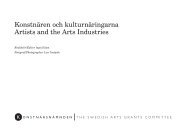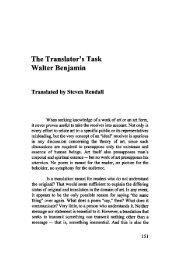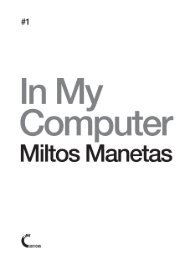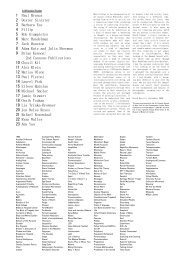Jürg Lehni – Typeface As Progamme - Harald Peter Ström
Jürg Lehni – Typeface As Progamme - Harald Peter Ström
Jürg Lehni – Typeface As Progamme - Harald Peter Ström
You also want an ePaper? Increase the reach of your titles
YUMPU automatically turns print PDFs into web optimized ePapers that Google loves.
creative sector, this also led to a change in the nature of the work being done, often<br />
to the disapproval of the previous specialists in the field. While type design in the<br />
19th century was a craft accessible to very few selected typographers who together<br />
with punch cutters worked on designs for one of the companies producing<br />
typesetting equipment, it is now a discipline that anyone who has access to a<br />
computer and a license for a type design software can engage in.<br />
These are generally known aspects of this revolution that have been looked at<br />
closely many times before. But the role of software is rarely analyzed beyond this<br />
point. It appears that the general function of the computer is still accepted simply<br />
as a simulation machine, and the question what software could or should provide in<br />
any given field is rarely raised. Instead, the status quo is often accepted as a given,<br />
a language we use in our daily work and that we have stopped questioning, since it<br />
is so ubiquitous that is it almost invisible.<br />
Furthermore, in the historic discourse of digital typefaces, questions regarding the<br />
definition and nature of digital typefaces are hardly risen and the status quo is<br />
rarely questioned beyond the boundaries of the industrial standards.<br />
Fonts, Tools and Software<br />
Traditionally, a font was a complete set of metal characters of a particular typeface<br />
in a given size and style. Etymologically, the word goes back to the French word<br />
fonte and the verb fondre, meaning to melt or to cast, referencing the way fonts<br />
were produced by type foundries. Fonts were one of the ingredients needed in the<br />
printing process in order to be able to print text, and they were bought in full sets<br />
from the foundries. A set included more copies of some letters than others,<br />
depending on the statistical occurrence of each letter in any given language. The<br />
structure of the letter cases that hold the letters represented this distribution.<br />
A font was not a full, independent tool in itself, but rather a part of a tool based<br />
process, which, without it could not take place. Given its physical nature at that<br />
time, it is imaginable that fonts were perceived as tools in themselves. At the same









